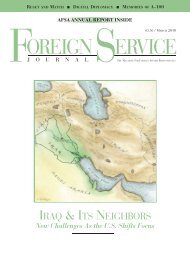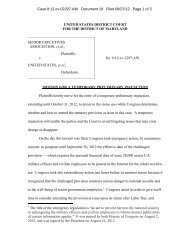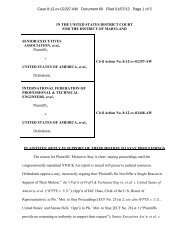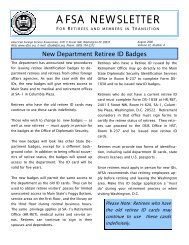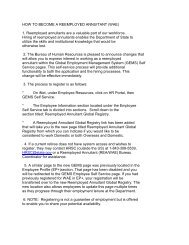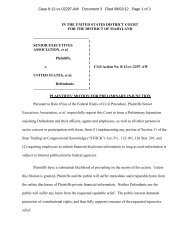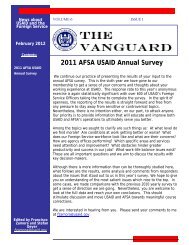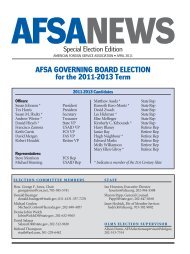F OCUS - American Foreign Service Association
F OCUS - American Foreign Service Association
F OCUS - American Foreign Service Association
Create successful ePaper yourself
Turn your PDF publications into a flip-book with our unique Google optimized e-Paper software.
order is a barrier to change, education,<br />
economic betterment and human<br />
rights. We cannot defeat this<br />
tactic by combat power alone.<br />
Instead, we have capitalized on<br />
our asymmetric advantage, the<br />
ability to offer both a better today<br />
and a better tomorrow. The<br />
United States is the largest donor<br />
to Afghanistan, carrying out comprehensive<br />
sector programs in agriculture<br />
and alternative development, infrastructure<br />
(roads and power), health, education, economic growth,<br />
good governance and the rule of law.<br />
In 2001, fewer than one million boys and no girls<br />
attended school in Afghanistan. Now, six million children<br />
(40 percent of them girls) regularly go to school. Infant<br />
mortality has been slashed. Eighty percent of all Afghans<br />
now have access to medical care. Licit exports have<br />
increased nearly 600 percent. The extent of paved or<br />
improved roads has been doubled to 40,000 kilometers.<br />
Each road brings development and stability: as the saying<br />
goes, “Where the roads end, the Taliban begins.”<br />
While worthwhile, it is a tremendous effort that often<br />
seems to proceed at a glacial pace.<br />
We are not alone in this fight. In addition to NATO/<br />
ISAF, the U.N., the Red Cross and a slew of nongovernmental<br />
organizations are on the ground. Unfortunately,<br />
however, many of these entities approach the complex<br />
Afghan environment the same way they have a dozen<br />
other conflict zones, regardless of whether their methods<br />
are appropriate or effective under the circumstances.<br />
Seeing this, the United States decided that a new<br />
approach was needed, and thus the Provincial<br />
Reconstruction Team concept was born.<br />
A Unique Institution<br />
Since their inception, PRTs have proven effective in<br />
supporting the spread of governance and development in<br />
Afghanistan. The first PRT was stood up in Paktia<br />
province in a traditional mud compound in 2002. Since<br />
then, 25 additional teams (11 U.S.-led and 14 non-U.S.)<br />
have been deployed throughout the country, mostly on<br />
small Forward Operating Bases located in provincial capitals.<br />
The U.S.-led teams combine civilian and military<br />
personnel who focus on governance, development and<br />
security.<br />
32 FOREIGN SERVICE JOURNAL/JULY-AUGUST 2008<br />
F <strong>OCUS</strong><br />
The integration of<br />
civilians is one of the<br />
major differences between<br />
the <strong>American</strong> effort and<br />
those of our allies.<br />
These civil-military teams work<br />
with the Afghan government, civil<br />
society, Afghan and coalition security<br />
forces, and the international<br />
community. Because the country’s<br />
provinces differ greatly in terms of<br />
ethnic and tribal mix, level of security<br />
and economic development,<br />
there can be no “cookie cutter”<br />
approach. That said, each PRT has<br />
a similar mandate: to extend the<br />
reach of the Afghan government, carry out reconstruction<br />
projects and help build up local security forces.<br />
Ten of the 12 U.S. PRTs are located in Regional<br />
Command East under the control of Combined Joint<br />
Task Force 101. The 101st also commands U.S. and<br />
coalition combat forces within its area of responsibility.<br />
Subordinate brigades coordinate the actions of both the<br />
PRTs and the combat units. It should be emphasized,<br />
however, that the PRTs are separate entities from the<br />
combat, or “maneuver” units.<br />
The PRTs have national identities, as well. Eleven of<br />
the 12 U.S. PRTs are military-led and have a handful of<br />
civilian officers — one each from State, USAID and<br />
USDA. The civilians are equal members of the PRT’s<br />
integrated command team. The military commander has<br />
final authority on all security matters, but the civilians<br />
take the lead on governance and development. By contrast,<br />
some non-U.S. PRTs are led by senior civilians with<br />
a sizable non-military staff, or by the military with civilian<br />
development advisers from the host country.<br />
There are also philosophical differences. U.S. PRTs<br />
are integrated civil-military counterinsurgency units.<br />
Other nations view PRTs either as development agencies<br />
with a military component for security, or as agencies that<br />
only provide security training. We believe that the U.S.<br />
model is the most effective, and some of our allies seem<br />
to be coming around to this view. There is a growing<br />
recognition by our British and Canadian colleagues<br />
(among others) that “the <strong>American</strong>s seem to have caught<br />
on to something.”<br />
The integration of non-military personnel is one of the<br />
major differences between the <strong>American</strong> effort and those<br />
of our allies. While other nations also assign civilians to<br />
their PRTs, the two sides often operate in virtual isolation<br />
from each other. In some non-U.S. PRTs, the relationship<br />
between them borders on hostility. In contrast, vis-



